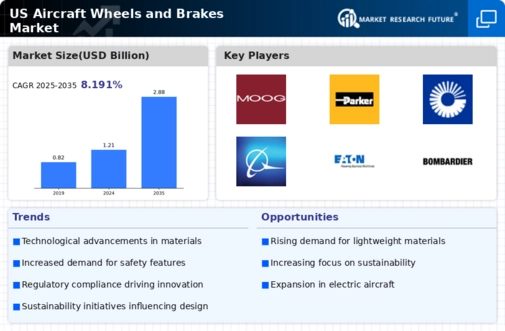Sustainability Initiatives
The aircraft wheels-brakes market is increasingly influenced by sustainability initiatives as manufacturers strive to reduce their environmental footprint. The aviation industry is under pressure to adopt greener practices, leading to the development of eco-friendly materials and processes in the production of wheels and brakes. In 2025, it is anticipated that sustainable materials will constitute around 20% of the total market share. This shift not only aligns with regulatory expectations but also appeals to environmentally conscious consumers and airlines. As a result, companies that prioritize sustainability are likely to gain a competitive edge in the aircraft wheels-brakes market.
Increased Air Travel Demand
The aircraft wheels-brakes market experiences a notable boost due to the rising demand for air travel in the United States. As airlines expand their fleets to accommodate growing passenger numbers, the need for reliable and efficient wheels and brakes becomes paramount. In 2025, the commercial aviation sector is projected to grow by approximately 5% annually, leading to increased orders for aircraft components. This surge in demand not only drives production but also encourages innovation in materials and technologies used in wheels and brakes. Consequently, manufacturers are compelled to enhance their offerings to meet the evolving needs of airlines, thereby propelling the aircraft wheels-brakes market forward.
Focus on Safety Enhancements
Safety remains a critical concern in aviation, significantly influencing the aircraft wheels-brakes market. Regulatory bodies in the United States impose stringent safety standards that manufacturers must adhere to, fostering innovation in braking systems. The market is witnessing a shift towards advanced braking technologies, such as anti-skid systems and lightweight materials, which enhance aircraft performance and safety. In 2025, investments in safety-related technologies are expected to account for over 30% of total expenditures in the aircraft wheels-brakes market. This focus on safety not only meets regulatory requirements but also reassures airlines and passengers, thereby driving market growth.
Growing Military Aviation Sector
The military aviation sector is a significant driver of the aircraft wheels-brakes market, particularly in the United States. With ongoing investments in defense and modernization programs, the demand for military aircraft is on the rise. In 2025, military aviation spending is projected to increase by approximately 4% annually, leading to heightened demand for specialized wheels and brakes designed for military applications. This growth not only supports the aircraft wheels-brakes market but also encourages manufacturers to develop tailored solutions that meet the unique requirements of military operations. As such, the military sector represents a vital opportunity for growth within the aircraft wheels-brakes market.
Technological Integration in Manufacturing
The integration of advanced technologies in manufacturing processes is reshaping the aircraft wheels-brakes market. Automation, artificial intelligence, and additive manufacturing are becoming increasingly prevalent, enhancing production efficiency and precision. In 2025, it is estimated that automated processes will account for nearly 40% of manufacturing operations in the market. This technological evolution not only reduces production costs but also improves product quality, enabling manufacturers to meet the high standards required by airlines. As a result, companies that embrace these innovations are likely to strengthen their position in the aircraft wheels-brakes market.























Leave a Comment